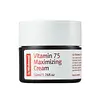What's inside
What's inside
 Key Ingredients
Key Ingredients

No key ingredients
 Benefits
Benefits

 Concerns
Concerns

 Ingredients Side-by-side
Ingredients Side-by-side

Hippophae Rhamnoides Extract
MaskingGlycerin
HumectantButylene Glycol
HumectantMethylpropanediol
SolventDipropylene Glycol
HumectantWater
Skin ConditioningNiacinamide
Smoothing1,2-Hexanediol
Skin ConditioningCyclopentasiloxane
EmollientHippophae Rhamnoides Fruit Extract
Skin ConditioningCyclohexasiloxane
EmollientSodium Polyacryloyldimethyl Taurate
Emulsion StabilisingBiosaccharide Gum-1
HumectantSodium Hyaluronate
HumectantPanthenol
Skin ConditioningDipotassium Glycyrrhizate
HumectantHydrogenated Polydecene
EmollientTrideceth-10
CleansingPortulaca Oleracea Extract
Skin ConditioningHamamelis Virginiana Extract
AntiseborrhoeicChamomilla Recutita Flower Extract
MaskingSaussurea Involucrata Extract
HumectantRubus Chamaemorus Fruit Extract
AntioxidantSelaginella Lepidophylla Extract
EmollientCarbomer
Emulsion StabilisingArginine
MaskingAllantoin
Skin ConditioningBambusa Vulgaris Water
Skin ConditioningNelumbo Nucifera Flower Water
TonicAloe Barbadensis Leaf Water
MaskingPentylene Glycol
Skin ConditioningCaprylhydroxamic Acid
Boswellia Serrata Resin Extract
SmoothingEthylhexylglycerin
Skin Conditioning3-O-Ethyl Ascorbic Acid
Skin ConditioningPhenoxyethanol
PreservativeHippophae Rhamnoides Extract, Glycerin, Butylene Glycol, Methylpropanediol, Dipropylene Glycol, Water, Niacinamide, 1,2-Hexanediol, Cyclopentasiloxane, Hippophae Rhamnoides Fruit Extract, Cyclohexasiloxane, Sodium Polyacryloyldimethyl Taurate, Biosaccharide Gum-1, Sodium Hyaluronate, Panthenol, Dipotassium Glycyrrhizate, Hydrogenated Polydecene, Trideceth-10, Portulaca Oleracea Extract, Hamamelis Virginiana Extract, Chamomilla Recutita Flower Extract, Saussurea Involucrata Extract, Rubus Chamaemorus Fruit Extract, Selaginella Lepidophylla Extract, Carbomer, Arginine, Allantoin, Bambusa Vulgaris Water, Nelumbo Nucifera Flower Water, Aloe Barbadensis Leaf Water, Pentylene Glycol, Caprylhydroxamic Acid, Boswellia Serrata Resin Extract, Ethylhexylglycerin, 3-O-Ethyl Ascorbic Acid, Phenoxyethanol
Hippophae Rhamnoides Water
MaskingButylene Glycol
HumectantHelianthus Annuus Seed Oil
EmollientGlycerin
HumectantCetearyl Alcohol
Emollient1,2-Hexanediol
Skin ConditioningCetearyl Olivate
Sorbitan Olivate
EmulsifyingHydroxyethyl Acrylate/Sodium Acryloyldimethyl Taurate Copolymer
Emulsion StabilisingBetaine
HumectantCaprylic/Capric Triglyceride
MaskingElaeis Guineensis Kernel Oil
EmollientPanthenol
Skin ConditioningMacadamia Ternifolia Seed Oil
EmollientDimethicone
EmollientBeeswax
Emulsion StabilisingElaeis Guineensis Oil
EmollientEthyl Hexanediol
SolventAllantoin
Skin ConditioningArginine
MaskingXanthan Gum
EmulsifyingCarbomer
Emulsion StabilisingEthylhexylglycerin
Skin ConditioningCitrus Limon Peel Oil
MaskingLimonene
PerfumingCitral
PerfumingHippophae Rhamnoides Water, Butylene Glycol, Helianthus Annuus Seed Oil, Glycerin, Cetearyl Alcohol, 1,2-Hexanediol, Cetearyl Olivate, Sorbitan Olivate, Hydroxyethyl Acrylate/Sodium Acryloyldimethyl Taurate Copolymer, Betaine, Caprylic/Capric Triglyceride, Elaeis Guineensis Kernel Oil, Panthenol, Macadamia Ternifolia Seed Oil, Dimethicone, Beeswax, Elaeis Guineensis Oil, Ethyl Hexanediol, Allantoin, Arginine, Xanthan Gum, Carbomer, Ethylhexylglycerin, Citrus Limon Peel Oil, Limonene, Citral
 Reviews
Reviews

Ingredients Explained
These ingredients are found in both products.
Ingredients higher up in an ingredient list are typically present in a larger amount.
1,2-Hexanediol is a synthetic liquid and another multi-functional powerhouse.
It is a:
- Humectant, drawing moisture into the skin
- Emollient, helping to soften skin
- Solvent, dispersing and stabilizing formulas
- Preservative booster, enhancing the antimicrobial activity of other preservatives
Allantoin is a soothing ingredient known for its protective and moisturizingg properties. Because of this, it is often added to products with strong active ingredients.
Studies show higher concentrations of this ingredient can promote wound healing.
Though it can be derived from the comfrey plant, allantoin is produced synthetically for cosmetic products to ensure purity.
Learn more about AllantoinArginine is an amino acid that is important for human development. Your body uses is it to produce hair keratin and skin collagen.
As a cosmetic ingredient, Arginine has antioxidant properties and can also help repair damaged skin. This ingredient is derived either synthetically or from animals.
Arginine isn't fungal acne safe when used in the presence of other lipids (fats, fatty acids, oils, esters, etc). Oils and fats occur naturally within the skin, so take caution when using Arginine if you're prone to fungal acne.
Learn more about ArginineButylene Glycol (or BG) is used within cosmetic products for a few different reasons:
Overall, Butylene Glycol is a safe and well-rounded ingredient that works well with other ingredients.
Though this ingredient works well with most skin types, some people with sensitive skin may experience a reaction such as allergic rashes, closed comedones, or itchiness.
Learn more about Butylene GlycolCarbomer is a polymer of acrylic acid. Its main role is to create a gel consistency.
A high amount of carbomer can cause pilling or balling up of products. Don't worry, most products contain 1% or less of carbomer.
Ethylhexylglycerin (we can't pronounce this either) is commonly used as a preservative and skin softener. It is derived from glyceryl.
You might see Ethylhexylglycerin often paired with other preservatives such as phenoxyethanol. Ethylhexylglycerin has been found to increase the effectiveness of these other preservatives.
Glycerin is already naturally found in your skin. It helps moisturize and protect your skin.
A study from 2016 found glycerin to be more effective as a humectant than AHAs and hyaluronic acid.
As a humectant, it helps the skin stay hydrated by pulling moisture to your skin. The low molecular weight of glycerin allows it to pull moisture into the deeper layers of your skin.
Hydrated skin improves your skin barrier; Your skin barrier helps protect against irritants and bacteria.
Glycerin has also been found to have antimicrobial and antiviral properties. Due to these properties, glycerin is often used in wound and burn treatments.
In cosmetics, glycerin is usually derived from plants such as soybean or palm. However, it can also be sourced from animals, such as tallow or animal fat.
This ingredient is organic, colorless, odorless, and non-toxic.
Glycerin is the name for this ingredient in American English. British English uses Glycerol/Glycerine.
Learn more about GlycerinPanthenol is a common ingredient that helps hydrate and soothe the skin. It is found naturally in our skin and hair.
There are two forms of panthenol: D and L.
D-panthenol is also known as dexpanthenol. Most cosmetics use dexpanthenol or a mixture of D and L-panthenol.
Panthenol is famous due to its ability to go deeper into the skin's layers. Using this ingredient has numerous pros (and no cons):
Like hyaluronic acid, panthenol is a humectant. Humectants are able to bind and hold large amounts of water to keep skin hydrated.
This ingredient works well for wound healing. It works by increasing tissue in the wound and helps close open wounds.
Once oxidized, panthenol converts to pantothenic acid. Panthothenic acid is found in all living cells.
This ingredient is also referred to as pro-vitamin B5.
Learn more about Panthenol